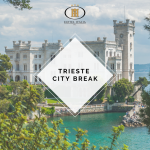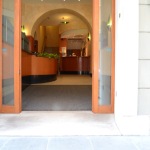Miramare Castle
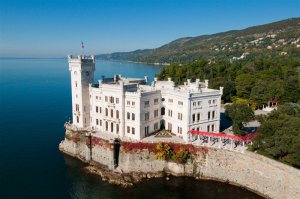
Miramare Castle
The castle of Miramare is a charming must-see. It is the most famous place of the Triestine coast, indissolubly bound to the landscape and history of Trieste. This magnificent building was built on the rock extending into the sea on Archduke Ferdinand Maximilian Joseph of Habsburg’s orders.
According to the legend, the Archduke was once overtaken by a storm at sea and found a shelter in the small bay of Grignano. He was enchanted by the place to the point that he decided to build his home right there. He lived there with his wife, Charlotte of Belgium.
In the sumptuous rooms, furnished in a variety of styles, the couple lived the most intense moments of their love story, abruptly interrupted by the tragic death of Maximilian in Mexico.
The castle is surrounded by a wide park – one of the widest in northern Italy (22 hectares). Its trees have been imported from all over the world: firs from Spain and Himalaya, cedars from northern Africa and Lebanon, cypresses and sequoias from America. Part of the park is an Italian-style garden with wide terraces sloping down gently to the sea.
Along the coast faced by the park of Miramare, the WWF has created a Sea Park: approximately 30 hectares in which the flora and fauna are preserved.
Castle of San Giusto
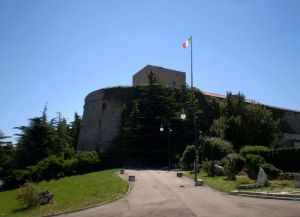
Castle of San Giusto
The Castle of San Giusto rises on the homonymous hill and dominates the whole city. Its construction began in 1450 on the remains of a Roman construction. Today, the castle hosts cultural events and the Civic Museum of the San Giusto Castle, rich in works of art and ancient weapons.
Castle of Duino
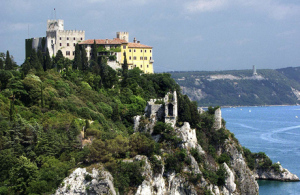
Castle of Duino
The castle of Duino is a composite and massive building with a 16th Century tower preserving its ancient structure.
It is around this tower, on the ruins of a Roman outpost, that in 1300 the construction of the current castle started, not far from the ancient castle that, according to tradition, was dedicated to the cult of the Sun God and that was romantically called ‘The White Lady’. It is still inhabited by the Princes of Turn und Taxis, who have preserved its warm, refined character.
As far as the Rilke path is concerned, this was named after the Portuguese poet (with Austrian origins) Rainer Maria Rilke, who stayed in the castle in 1911 and 1912, as guest of the Princes of Turn und Taxis: according to tradition, the verses of his Duinese Elegies were inspired by the path itself. The path stretches for 2 km, from Duino to Sistiana, in an amazing natural environment made of woods and overhanging cliffs providing a breath-taking view of the sea.
More info: 34013 Duino-Aurisina TS, Phone: 040 208120, Fax: 040 208022
Tram de Opcina
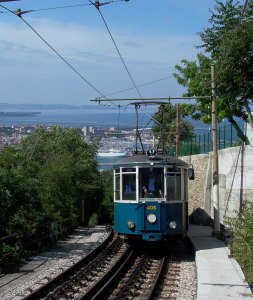
Tram di Opicina
This rack tram has linked the town centre to the uplands since 1902. The steep journey up offers a marvellous view of the town and the Gulf of Trieste. The tram stop at the Obelisk is at the beginning of a panoramic path leading to Prosecco village.
Foiba of Basovizza
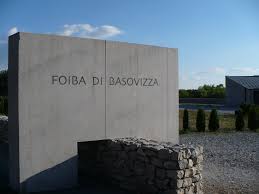
Foiba di Basovizza monument
The Foiba of Basovizza, a natural sinkhole hundreds of metres deep, is one of the most tragic and unknown places of the recent Italian history.
After the division of the city of Trieste in two zones, several Triestines who wanted the city to be unified and annexed to Italy were thrown here.
Just like the Risiera di San Sabba (a rice-husking facility used as Nazi concentration camp), it is now a national monument.
Risiera di San Sabba
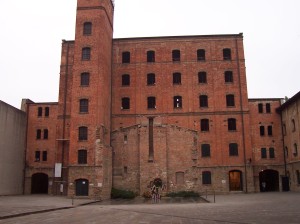
Risiera di San Sabba
The Risiera di San Sabba was a rice-husking facility used as Nazi concentration camp in Trieste. It was used for the transit, detention and elimination of a great number of prisoners, mainly political prisoners. It was the only Italian concentration camp in Italy to be equipped with a crematorium.
Civico Museo della Risiera di S. Sabba
Via G. Palatucci, 5
Tel. 040 826202
National monument since 1965. Built as a rice-husking factory, during the German occupation the Risiera was first converted into a clearing station for the concentration camps and then into Italy’s only extermination camp, equipped with a cremation furnace.
Teatro Romano and Arco di Riccardo
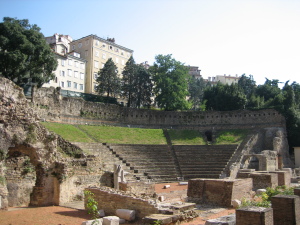
Teatro Romano
The Teatro Romano – Roman Theatre of Trieste lies at the foot of the San Giusto hill, right in the heart of the city, close to the old town, between Via Donota and Via del Teatro Romano. The theatre dates back to the 1st-2nd Century, when it was right beside the sea. Its steps, exploiting the natural slope of the hill, hosted almost 6.000 spectators. It was probably built on Quinto Petronio Modesto’s orders, officer of the Roman emperor Traiano, cited in several inscriptions.
Through the centuries, it was covered by other buildings and considered lost. In 1814 it was rediscovered by architect Pietro Nobile, but was brought to light only in 1938, during the demolition of part of the old town. The statues and inscriptions found in the excavation site can now be seen in the Civic Museum of Art and History.
Nowadays, the theatre is still used for outdoor summer shows from time to time.
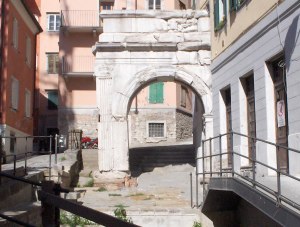
Arco Riccardo
This Roman gate dates back to the first Century BC, and was part of the Augustan walls built around the city.
Faro della Vittoria
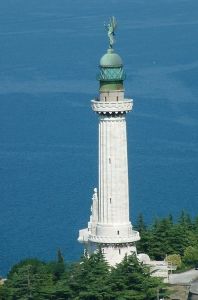
Faro della Vittoria
Built by the Triestine architect Arduino Berlam and by the sculptor Giovanni Mayer, the white “Faro della Vittoria” (Victory Lighthouse) lighting the Gulf of Trieste is a commemorative monument dedicated to the fallen of the First World War as testified by the inscription: “Shine and remind of the fallen on sea”. The lighthouse is made up by a wide base including the earthwork of a pre-existing Austrian fort and is covered by blocks of local stones. Above the column there is a “capital” supporting the “crow’s nest” – so called with a clear reference to the ship mast – in which a lantern is inserted, with its bronze and crystal cage covered by a copper dome decorated with a scale-like motif. The top of the dome is surmounted by the copper statue of the Victory. The ornamental part is completed by the sculpture of a seaman, under which the anchor of the Audace torpedo-boat (the first Italian ship that entered the port of Trieste on November 3, 1918) is set. Moreover, two projectiles donated by the Italian Navy are placed on both sides of the lighthouse entrance. Nowadays the lighthouse is one of the symbols of the city.
Literary Itineraries in Trieste
Many famous men spent their lives in Trieste, and walking in their footsteps can prove both intriguing and interesting.
Ettore Schmitz, aka Italo Svevo, was born in Trieste in 1861 and was a friend of James Joyce. He is one of the greatest writers of contemporary Italian literature. The places of his life and those mentioned in his novels (A life, Emilio’s carnival and Zeno’s Conscience) can still exert some fascination: the house where he was born at Viale XX Settembre 16; the Schmitz family residence at Via Carducci 12; the Istituto Commerciale Revoltella (a business school) at Via Battisti 12, which he attended after his studies at the Jewish school at Via del Monte 3; the Berlitz school at Piazza Ponterosso 4, where he studied English and met Joyce, one of the teachers there; the Banca Union at Via Einaudi 1, his first place of work; Caffè Garibaldi in piazza Unità d’Italia; the Biblioteca Civica (town library) at Piazza Hortis 4, where he read the great European writers discussed in his articles; Villa Veneziani and factory at Via Italo Svevo 22/24; Villa Tika at Via Nazionale 18 and Villa Letizia at Via Basovizza 8 in Opicina.
James Joyce was born in Dublin in 1882 and died in Zurich in 1941. He is one of the most important European writers of the 20th Century. He lived in Trieste twice, from 1904 to 1915 and from 1919 to 1920, where he finished writing the Dubliners and A Portrait of the Artist as a Young Man. He composed the short prose-poem Giacomo Joyce and a play called Exiles here and he also began writing his famous work of Ulysses, writing some of its most significant chapters in this town. The Irish writer moved several times during his stays in Trieste and all his homes can be found across the town, as can the myriad places he often visited.
Trieste can also be enjoyed through the eyes of another famous poet, Umberto Saba, the son of Ugo Abramo Poli and Rachele Coen; his pen name was taken from his beloved nanny’s name. He entitled his first collection of poetry ‘With my eyes’ (1912); in this poetry he sees himself through his hometown. Trieste is a constant, important presence in all the poet’s work. You can still find the Saba bookstore the poet ran from 1919 in via S. Nicolò.
Another noteworthy writer, Scipio Slataper, was born in Trieste on July 14th 1888 and died on December 3rd 1915, at Podgora, fighting with the Italians. In “Il mio Carso“, he deals with the relationship between Trieste and its Slovenian hinterland and their ensuing peculiarities.
Fulvio Tomizza, who was born in Materada, Istria in 1935 and died in Trieste in 1999, was consciously sympathetic to the heartache of those who lived in these lands (Materada, The Girl from Petrovia, The Acacia Wood).
Last but not least, the famous British consul, explorer, translator and orientalist Richard Francis Burton (1821-1890) spent the last part of his adventurous life in Trieste. Here he wrote a book on the Roman Baths in Monfalcone and his best known book by far: the translation of The Arabian Nights, published in sixteen volumes from 1885 to 1888 with his title of The Book of a Thousand nights and a night.
Muggia

Muggia
Muggia and its surroundings are important tourist locations. This green territory is bordered by 7 km of coast and hills that dominate a wide view of both the Italian and Slovenian coast. Muggia is rich in ancient remains, such as the ruins of protohistoric fortresses of Santa Barbara and Muggia Vecchia, where the Basilica of Saint Mary of the Assumption (19th Century) is the sole evidence – along with the remains of the boundary walls – of a Roman and Medieval past.
Before year 1000, a small village called Borgolauro formed in what is currently the town’s centre; that is where in 1256 the Commune of Muggia was constituted. The Duomo and the Town Hall – rebuilt in the 20th Century – date back to that same period.
In 1420 Muggia was taken by Venice, which left its mark on the town in the dialect, the gastronomic traditions, the Venetian Gothic architecture.
Nowadays, Muggia is still characterised by tradition, which can be found in the typical ‘calli’(narrow streets) and in the marvellous Piazza Marconi, the heart of the town, or in the port, where fishermen work. The small port in san Bartolomeo is particularly striking.
Moreover, for a few years now, the new recreational boating port Porto San Rocco has been open for use.



